Accelerate Automotive System Design with Cadence AI-Driven DSPs
The automotive industry is on the brink of a transformative era powered by intelligence, safety, and seamless user experiences. Integrating digital signal processing and artificial intelligence (AI) transforms vehicle intelligence. It enhances user experiences, crucial in next-generation features such as advanced driver-assistance systems (ADAS), in-cabin sensing, infotainment, and overall system design. Cadence is essential in supporting this through its advanced AI-driven digital signal processors (DSPs). These innovations make vehicles safer, smarter, and more engaging.
At CadenceLive Silicon Valley 2025, Amit Kumar, Director of Product Management and Marketing, emphasized how Cadence’s specialized DSPs and AI intellectual property (IP) cores are key to developing future automotive systems. This blog is an excerpt from that presentation. It discusses how AI-powered DSPs foster innovation in the automotive industry and how Cadence enables this modernization.
The Impact of AI-Powered DSP Technology on Automotive Innovation
The automotive industry is rapidly evolving in response to the growing demands for greater safety, autonomy, and enhanced user experience. Modern vehicles are no longer just modes of transport—they are intelligent, connected platforms. The shift towards an AI-driven future redefines every aspect of automotive systems, chiefly through ADAS, in-cabin sensing, and immersive audio experience.
ADAS and Autonomy
ADAS has progressed from enhancing driver safety to enabling fully autonomous driving capabilities. This evolution involves:
- Perception sensors such as cameras, radars, LiDAR, and thermal systems
- Sophisticated signal processing for object detection, mapping, and trajectory planning. DSP cores in these systems ensure real-time data processing with minimal latency and low power consumption
- Integration of AI algorithms, such as convolutional neural networks (CNNs), recurrent neural networks (RNNs), and vision transformers, enhances perception and decision-making accuracy
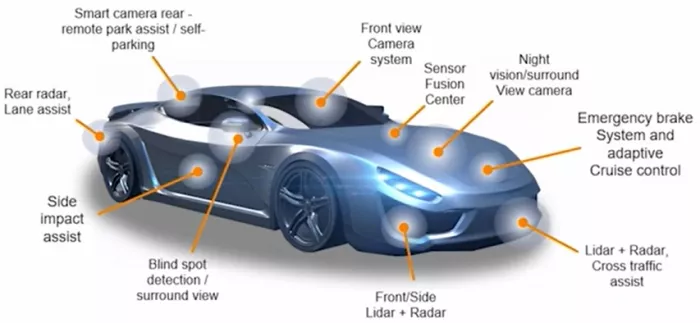
The progression from Level 0 to Level 5 autonomy relies heavily on the seamless operation of these technologies. Here, DSP cores play a pivotal role, offering real-time processing at high computational speeds and ensuring the smooth functioning of ADAS/AD.
In-Cabin Sensing for Safety and Comfort
Modern vehicles are designed to be as intuitive and passenger-centered as possible. DSP-driven in-cabin sensing systems employ AI technologies to:
- Monitor child presence detection (CPD) and driver conditions (DMS)
- Perform vital signs monitoring to ensure emergency preparedness
- Improve situational safety by integrating data from a spectrum of sensors, including vision and radar modalities
Mandates by organizations like Euro NCAP and the demand for enhancing user experience are pushing car manufacturers to adopt in-cabin sensing solutions powered by AI and DSP technologies.
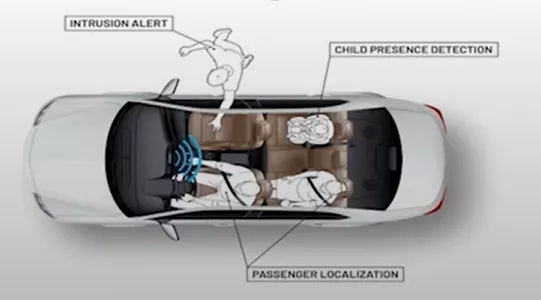
Infotainment and Immersive Audio Experiences
A significant aspect of vehicle user experience is connected to how well in-cabin entertainment functions. DSP cores are renovating this area by enabling:
- AI-enhanced audio processing to reduce noise, improve clarity, and create immersive soundscapes
- Zonal audio technologies like "audio bubbles" to localize sound experiences for individual passengers
- AI-based acoustic enhancements include engine sound augmentation and tailored noise cancellation
These new features need to process data from multiple sensors, integrate AI for inferencing and real-time decision-making, and use advanced audio DSPs for an immersive audio experience.
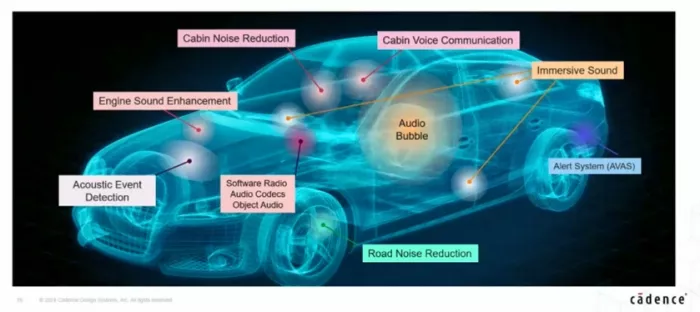
Cadence's Role in Driving Automotive Transformation with AI-Driven DSP
Think about the massive amount of data generated by AI adoption and captured by various sensors! How to process the data efficiently, and that too while ensuring safety along with the least latency? Cadence offers automotive-grade solutions that help accelerate innovation and offer multiple benefits, such as
- Single DSP for sensor fusion: Cadence Tensilica Vision 331 and 341 DSPs eliminate the need for multiple DSPs and offer a large software ecosystem, enabling fast time to market with the same SIMD and VLIW architectures
- Hardware accelerator for 4D imaging radar: The Cadence Tensilica Vision 4DR accelerator offers greater performance and performance/area advantage when paired with new DSPs for 4D imaging radar applications
- AI accelerator for growing neural network workloads: NeuroEdge NPUs target a broad range of AI applications for ADAS/AD with a low energy footprint
- High-performance DSP for Audio workloads: Tensilica HiFi DSPs for audio applications with 200+ codecs and SW enhancement packages enable offloading engine for audio applications
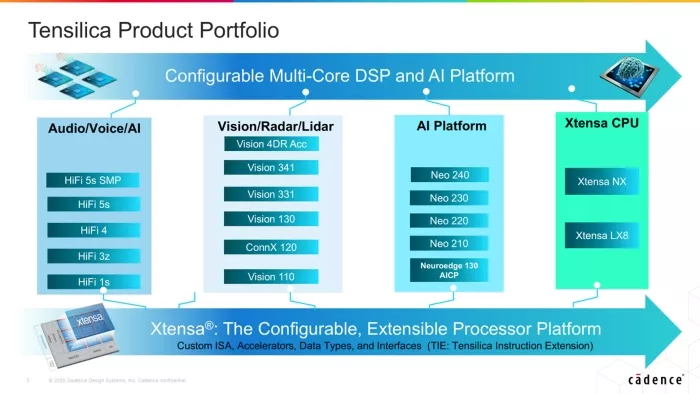
Multi-Modal Perception Sensing
Cadence offers dedicated DSP IP for processing various sensor modalities—radar (short, medium, long-range, 4D imaging), cameras (RGB, IR, stereo/trinocular), LiDAR, and thermal sensors. Cadence Vision DSPs are optimized for complex video and imaging tasks. These IP are tailored to aggregate, preprocess, and post-process massive amounts of data in real time for ADAS/autonomous driving applications.
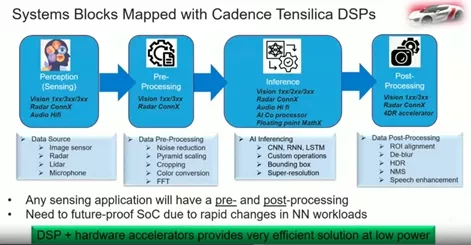
Cadence’s vision and radar DSPs are deeply embedded within automotive SoC architectures, handling complex signal processing chains essential for perception, planning, and control.
Advanced AI Integration
Cadence’s solutions deliver future-proof neural processing capabilities as AI workloads grow in complexity. Cadence AI accelerators, including the Neo and NeuroEdge series, are integrated into SoCs to provide real-time AI inference for object detection, classification, lane detection, mapping, and trajectory prediction tasks. The NeuroEdge 130 AI engine can adapt to rapidly changing AI workloads without significant hardware updates. With these innovations, Cadence is setting the pace in delivering efficient and scalable AI solutions for mid and high-level processing needs in automotive systems.
Transforming In-Cabin Sensing
Cadence DSPs power in-cabin sensing systems, ranging from driver monitoring to full-cabin awareness. Solutions target safety features such as child presence detection (Euro NCAP compliance), vital signs monitoring, and behavior analytics, all processed in real time for adaptive comfort and improved occupant safety.
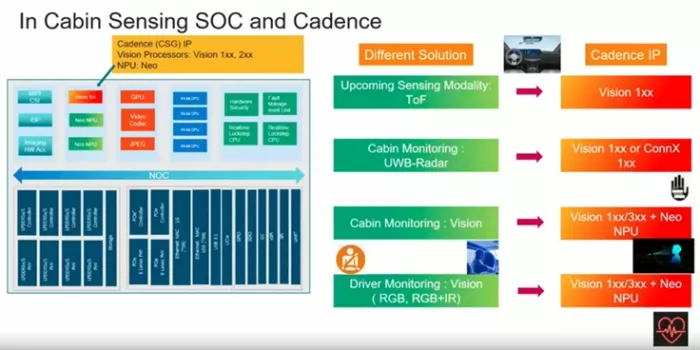
By embedding DSPs within automotive SoCs, Cadence ensures a prompt, adaptive response to changing cabin environments.
Advancing Infotainment and Audio Innovation
Cadence’s Tensilica HiFi DSP solutions are powering the next generation of infotainment systems, enabling these advancements while maintaining energy efficiency. Cadence’s HiFi DSP cores enable advanced audio features such as noise reduction, beamforming, personalized audio zones (audio bubbles), and immersive head-unit and speaker configurations across the vehicle. The architecture supports classical audio processing (noise filtering, encoding/decoding) and AI-driven workloads—sound classification, voice agents, event detection, and acoustic enhancements—all natively on DSPs, reducing the need for separate processing hardware. Cadence collaborates with ecosystem leaders to deliver cutting-edge infotainment experiences.
System Certification and Ecosystem Support
Functional safety is a non-negotiable element of automotive system design. Cadence ensures its DSP solutions adhere to ISO 26262 standards, vital for automotive safety integrity. Cadence's automotive products are ISO 26262 certified, ensuring the functional safety required for critical in-vehicle systems. The effectiveness of Tensilica DSP solutions can be seen in partnerships with industry leaders. These collaborations have resulted in innovative applications, including:
- Highly accurate 4D imaging radar systems
- Ultra-reliable driver assistance modules
- Immersive and customizable in-cabin audio systems
Cadence’s strong ecosystem of over 200 partners ensures seamless integration of DSP technologies into automotive designs, reducing time-to-market and enhancing end-user satisfaction. The table below highlights Cadence’s DSP and AI Solutions in automotive.
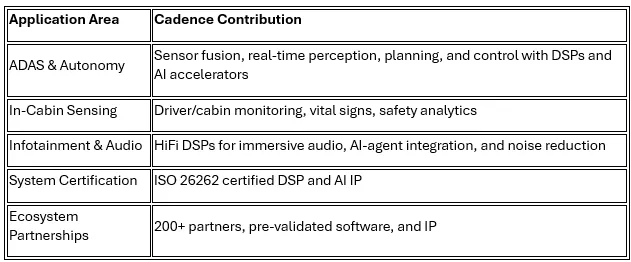
Conclusion: Driving Toward an AI-Powered Future
Integrating AI-driven DSP technologies in automotive system design transforms how vehicles operate, paving the path for autonomy, safety, and unparalleled user experiences. Cadence’s Tensilica DSP solutions are at the forefront of this evolution, empowering manufacturers to meet the growing technological demands.
By addressing challenges in real-time processing, sensor integration, and AI adaptation, Cadence is driving the development of next-gen vehicles and ensuring that safety, efficiency, and innovation remain paramount.
The future of the automotive industry is undeniably intelligent, and Cadence is a pioneer in shaping it with tools and technologies that redefine the landscape of modern transportation. Visit Cadence to explore their portfolio and be part of this transformative journey.
Related Semiconductor IP
- 5G IoT DSP
- 5G RAN DSP
- 32-bit 8-stage superscalar processor that supports RISC-V specification, including GCNP (DSP)
- Compact High-Speed 32-bit CPU Core with DSP
- 16-bit fixed-point general purpose DSP
Related Blogs
- Himax Accelerates Chip Design with Cadence Cerebrus Intelligent Chip Explorer
- Samsung Foundry and Synopsys Accelerate Multi-Die System Design
- Synopsys Collaborates with Arm to Drive Automotive Design Excellence
- Streamline PCIe 6.0 Switch Design with Effective Verification Strategies
Latest Blogs
- Design specification: The cornerstone of an ASIC collaboration
- The importance of ADCs in low-power electrocardiography ASICs
- VESA Adaptive-Sync V2 Operation in DisplayPort VIP
- Design, Verification, and Software Development Decisions Require a Single Source of Truth
- CAVP-Validated Post-Quantum Cryptography
